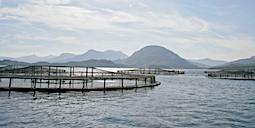The Scottish Salmon Company (SSC) said its harvest volumes in the first half of 2017 fell to 11,617 tonnes from 13,123 tonnes for the same period of 2016.
Despite the lower volumes, operating revenues in the six months to June 30 increased to a record £72 million from £57.6 million in the first half of 2016.
The Scottish salmon industry has a major ongoing problem with sea lice.
“The successful performance in the first half of 2017 has been underpinned by a strong market for Scottish salmon, increased weight of harvested stock and a strong focus on operational performance,” said Edinburgh-based and Norway-listed SSC.
“The lower harvest volumes in the first part of 2017 were as a result of the biological challenges experienced during the second half of 2016,” said SSC.
“However, in H1 2017 the ability of SSC to manage the biological situation improved significantly.
“During the period the use of a new hydrolicer has been implemented and the cleaner fish programme has been extended …
“SSC is working closely with the industry and key stakeholders to ensure there is a supportive regulatory framework in place allowing the sector to meet its economic potential.
“As of today, the regulatory framework remains challenging for the Scottish farming industry.
“In June SEPA, the environmental regulator in Scotland, published a report for consultation making recommendations to reduce the volume of SLICE (emamectin benzoate), an approved treatment for sea lice.
“While SSC is proactively engaged in industry projects to develop alternative treatments, SLICE currently plays a vital role in controlling naturally occurring parasites.
“SSC is working closely with the industry body, the Scottish Salmon Producers’ Organisation (SSPO), to respond to this consultation and will challenge these recommendations where necessary to avoid excessive regulations that unnecessarily hamper industry production and growth.”
